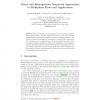Free Online Productivity Tools
i2Speak
i2Symbol
i2OCR
iTex2Img
iWeb2Print
iWeb2Shot
i2Type
iPdf2Split
iPdf2Merge
i2Bopomofo
i2Arabic
i2Style
i2Image
i2PDF
iLatex2Rtf
Sci2ools
ICCS
2004
Springer
2004
Springer
Direct and Homogeneous Numerical Approaches to Multiphase Flows and Applications
We have studied two approaches to the modeling of bubbly and cavitating fluids. The first approach is based on the direct numerical simulation of gas bubbles using the interface tracking technique. The second one uses a homogeneous description of bubbly fluid properties. Two techniques are complementary and can be applied to resolve different spatial scales in simulations. Numerical simulations of the dynamics of linear and shock waves in bubbly fluids have been performed and compared with experiments and theoretical predictions. Two techniques are being applied to study hydrodynamic processes in liquid mercury targets for new generation accelerators.
| Added | 01 Jul 2010 |
| Updated | 01 Jul 2010 |
| Type | Conference |
| Year | 2004 |
| Where | ICCS |
| Authors | Roman Samulyak, Tianshi Lu, Yarema Prykarpatskyy |
Comments (0)

